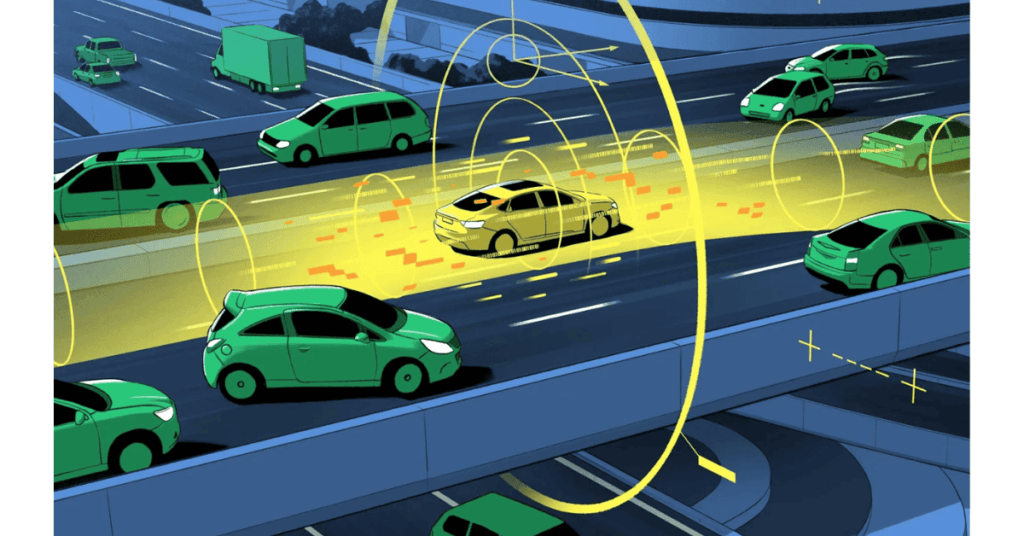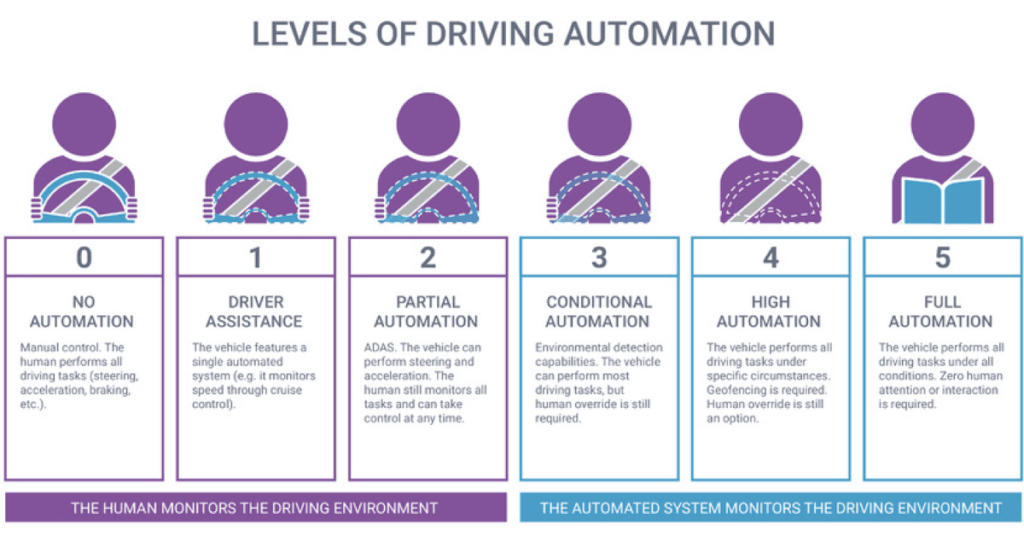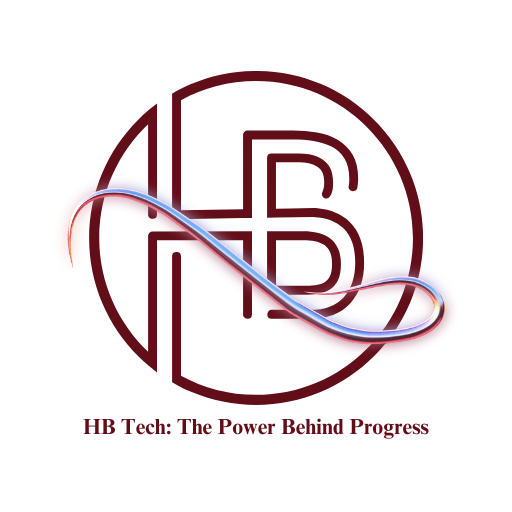Autonomous Vehicles
Autonomous vehicles also called Self-Driving Cars, are vehicles that can drive themselves without needing human control. They use a mix of sensors, cameras and advanced technology like artificial intelligence (AI) to understand their surroundings and make driving decisions. These vehicles can steer, accelerate, brake, and avoid obstacles all on their own , offering a new kind of freedom and convenience when it comes to transportation.

There are different levels of automation in autonomous vehicles . Some cars might only help with basic tasks, while others are fully capable of driving without any human input.
Levels of Autonomous Vehicles

Autonomous vehicles are categorized into six levels, ranging from no automation at all to fully self-driving :
- Level 0: No automation—humans do all the driving .
- Level 1: Driver assistance—features like cruise control or lane-keeping assist, but the driver is still in control.
- Level 2: Partial automation—vehicles can control steering and speed , but the driver must still pay attention.
- Level 3: Conditional automation—vehicles can drive themselves in certain conditions, But the driver must be ready to take over if needed.
- Level 4: High automation—vehicles can operate independently in most environments, but they may stll need a driver in some cases.
- Level 5: Full automation—no human input required at any time in any condition.
Autonomous Vehicles Works

Autonomous vehicles rely on several key technologies to drive safely :
- Sensors and Cameras: These devices help the car “see” its surroundings, detecting obstacles, road signs, other cars and pedestrians.
- Radar and Lidar: Radar uses radio waves, while Lidar uses laser beams to map the car’s environment in great detail. Both technologies help the car detect objects even in low visibility.
- Artificial Intelligence (AI): AI processes all the information from the car’s sensors and cameras to make decisions in real-time. This allows the vehicle to navigate, plan routes and react to changes in its environment.
- Connectivity: Some autonomous vehicles are connected to other cars or the cloud, sharing data that can help them avoid accidents, manage traffic or find the best routes.
Benefits of Autonomous Vehicles
The rise of self-driving cars promises several potential benefits :
1. Safety Improvements
Human error causes most car accidents—things like distracted driving or speeding. Autonomous vehicles aim to reduce accidents by removing human mistakes from the equation. With sensors and AI constantly monitoring the environment, AVs can react faster and more precisely, reducing the risk of crashes .
2. Less Traffic
Self-driving cars can communicate with each other and optimize their routes, which could reduce congestion on the roads. This means smoother traffic flow and shorter travel times for everyone.
3. Better Mobility for All
Autonomous vehicles could be a game-changer for people who are unable to drive, like the elderly or people with disabilities. By removing the need for a human driver, AVs make transportation more accessible for everyone.
4. Environmental Impact
Self-driving cars could also help the environment. If combined with electric vehicle technology, AVs could reduce emissions and fuel consumption. Smart driving patterns , such as avoiding sudden stops or speeding, would make driving more efficient and eco-friendly.
Challenges to Overcome
While the potential for autonomous vehicles is huge, there are still some hurdles to tackle :
- Laws and Regulations: Governments need to create rules for testing, safety standards and how AVs should interact with other vehicles on the road.
- Technical Limitations: While AV technology is advancing rapidly, self-driving cars still face challenges with certain situations—like extreme weather, construction zones, or unpredictable human drivers .
- Ethical Dilemmas: In emergency situations, autonomous vehicle may have to make tough decisions, like how to avoid a crash. These situations raise important questions about programming and responsibility.
- Job Displacement: With self-driving technology, some jobs, like truck driving or taxi services, could be replaced. This could lead to job losses , so it’s important to think about retraining workers for new roles.
The Road Ahead
Although fully autonomous vehicles are still in development, many companies, including Tesla, Waymo and Uber, are already testing self-driving cars. In the future, we can expect more autonomous features to be added to cars , with full self-driving capabilities gradually becoming available.
The potential for AVs is enormous. They could make roads safer, reduce traffic and help people who cannot drive. However, there are still challenges, especially in technology and regulation,before autonomous vehicles become a common sight on the roads. The future of transportation is on the horizon and it looks like it’s going to be an exciting one.
Autonomous vehicles are set to change the way we think about driving. With the ability to reduce accidents, ease traffic, and provide transportation for everyone, self-driving cars could be the future of how we get around. Although there are challenges ahead , the benefits of this technology make it clear that autonomous vehicles are not just a far-off idea they’re already on their way to becoming a big part of our everyday lives.
Frequently Asked Questions(FAQs)
What are autonomous vehicles?
Autonomous vehicles (AVs), also known as self-driving cars, are vehicles that can drive themselves without human input. they use sensors, cameras, radar, lidar, and artificial intelligence (AI) to navigate and make driving decisions, including steering, braking, and accelerating.
How do autonomous vehicles work?
Autonomous vehicles rely on a combination of sensors, cameras, and radar to “see” their surroundings. AI processes the data from these sensors to make real-time decisions, such as detecting obstacles, planning routes and avoiding accidents. These vehicles can also communicate with other cars & the cloud for additional safety and efficiency.
What are the levels of automation for autonomous vehicles?
The levels of automation range from Level 0 (no automation) to Level 5 (full automation).
Level 0: No automation—humans control everything.
Level 1: Driver assistance, like cruise control.
Level 2: Partial automation, where the vehicle controls some tasks but the driver must remain alert.
Level 3: Conditional automation, where the car drives itself but the driver must be ready to intervene.
Level 4: High automation, where the vehicle can drive independently in most conditions.
Level 5: Full automation, where the car can drive itself under any condition without human involvement.What are the benefits of autonomous vehicles?
Autonomous vehicles offer several benefits:
Improved safety by reducing human error, which is responsible for most traffic accidents.
Less traffic by optimizing routes and communicating with other vehicles.
Better mobility for people who cannot drive, such as the elderly or disabled.
Environmental benefits by reducing fuel consumption and emissions, especially if paired with electric vehicle technology.What are the challenges of autonomous vehicles?
Despite their potential, autonomous vehicles face challenges, including:
Regulatory issues: Governments need to develop laws and standards for testing and using AVs on public roads.
Technical limitations: AVs still struggle with certain scenarios, like bad weather or unpredictable human drivers.
Ethical concerns: AVs may face situations where they need to make tough decisions, such as how to react in an unavoidable accident.
Job displacement: Self-driving vehicles may replace jobs in industries like truck driving, leading to job losses and the need for workforce retraining.Can autonomous vehicles make driving safer?
Yes, autonomous vehicles have the potential to make driving safer by reducing accidents caused by human error, such as distracted driving, speeding, and driving under the influence. With sensors and AI constantly monitoring the vehicle’s surroundings, AVs can respond faster and more accurately to potential hazards.
What is the future of autonomous vehicles?
The future of autonomous vehicles is promising, though there are still hurdles to overcome, such as technical limitations, regulations, and ethical concerns. In the coming years, we can expect more advanced autonomous features in vehicles, and fully self-driving cars may become a common sight on the roads as the technology matures.
Related Posts
- 2-in-1 Laptops: Tablets and Laptops in One
- 5G Technology: What It Is, It Works and Impact on Our Lives
- 8K Gaming on a Laptop: Is It Worth It?
- A Simple Guide to Remote Work: Work from Anywhere, Anytime
- A Visit to the Museum of Jurassic Technology
- Affordable AI Solutions for Small Businesses









